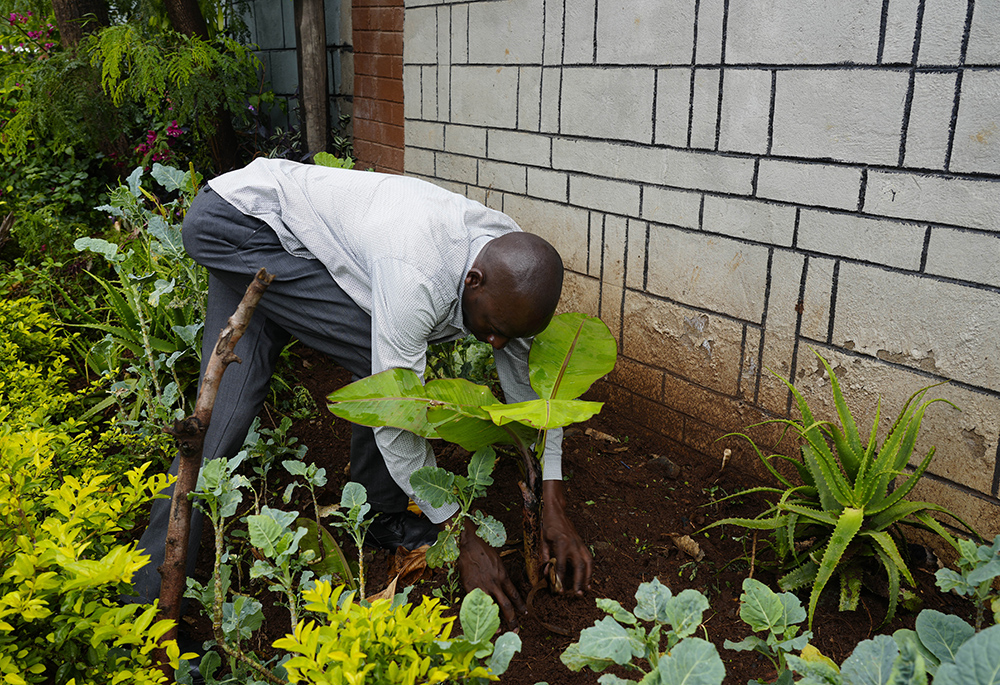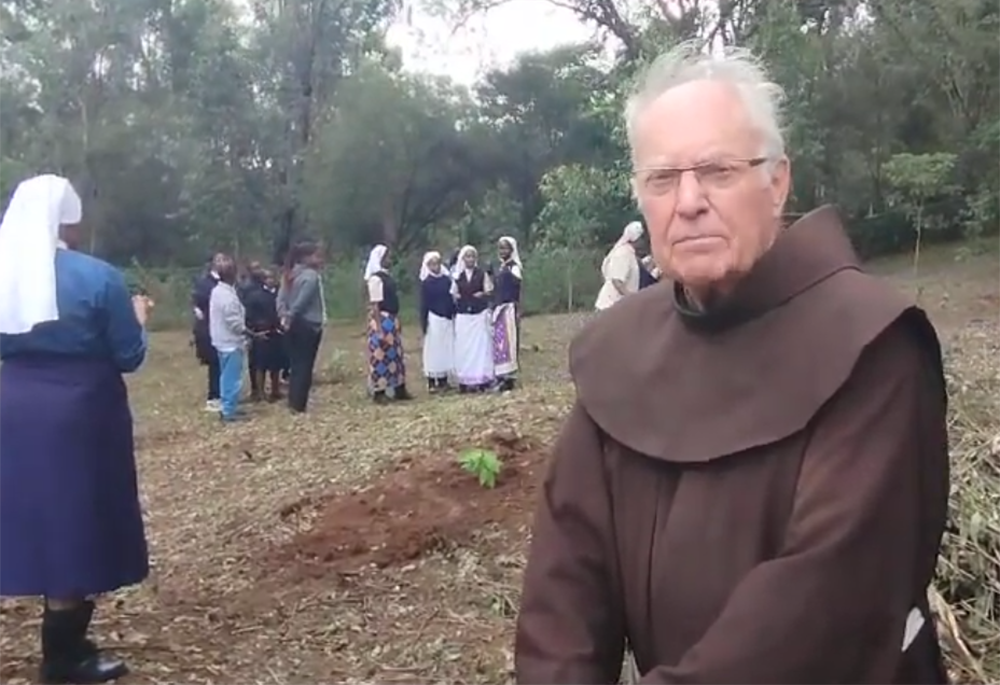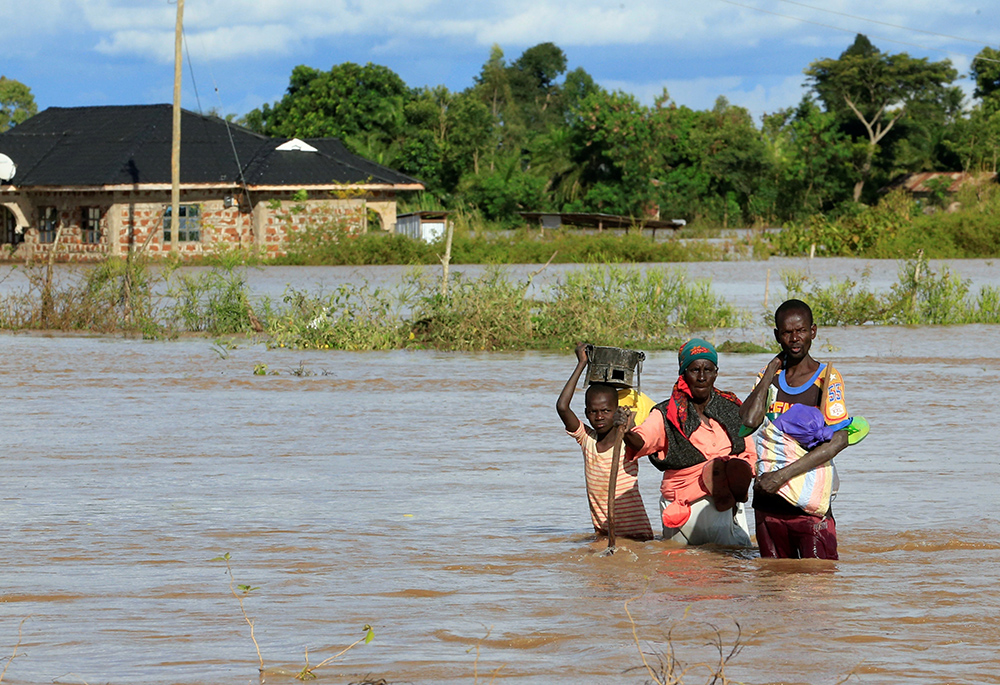
A resident plants a banana tree outside his house in Nairobi, Kenya, on Nov. 13, 2023. The Diocese of Kakamega is partaking in the restoration of the degraded Maragoli Forest, located about 248 miles west of Nairobi. (AP photo/Sayyid Abdul Azim)
In an effort to strengthen the spirit of Laudato Si' and further movement on care for creation, the Catholic Diocese of Kakamega is enthusiastically partaking in the restoration of the significantly degraded Maragoli Forest in western Kenya.
The hill forest, located about 400 kilometers (248 miles) west of Kenya's capital, Nairobi, is a vital ecosystem that provides habitat for diverse flora and fauna. But illegal logging, unsustainable harvesting of herbal medicines, charcoal burning, firewood collection, animal grazing and community encroachment are threatening this once pristine forest.
With more than 1,000 acres of the forest damaged and degraded, surrounding communities are subjected to unforgiving climate impacts, like recurrent drought, hunger and flooding.
Despite several attempts by the government, the local bank and other organizations, the restoration process has not reached its goals, but now with the involvement of Mother Earth Network and other partners, hope — and the forest — is being restored.
The project, under Mother Earth Network's founder Franciscan Fr. Hermann Borg, is committed to restore more than 1,000 acres of the forest. The faith-based organization aims to bolster restoration plans, targeting to plant more than 300,000 seedlings of both Indigenous and other species in the next five years.
"We've already committed $140,000 for this program, the funds will be used in all matters concerning conservation at Maragoli Forest," Borg told EarthBeat.

Franciscan Fr. Hermann Borg is pictured in a screenshot from a video posted online by Justice and Peace and Integrity of Creation for the Franciscans in Africa. Borg's Mother Earth Network is involved in the restoration of Maragoli Forest. The organization is targeting to plant more than 300,000 seedlings in the next five years. (NCR screenshot/YouTube/JPIC FA)
The church responded to this initiative after the local communities in collaboration with the local government submitted a proposal asking for assistance from the organization.
Borg said that the role of the Catholic Church is not only to preach God's Gospel but also to protect Mother Nature as it is written in Pope Francis' 2015 encyclical "Laudato Si', on Care for Our Common Home."
This restoration program is expected to breathe new life into the forest and the surrounding villages that have been experiencing the ravages of climate change for decades.
Commonly known as "Baba Miti" ("The Father of Trees"), Borg is hopeful that the project will successfully plant trees and nurture them to maturity, just like other projects the church has done across the country and beyond.
Borg mentioned the Subukia Catholic shrine in Nakuru County's Rift Valley Region as the most successful program he has undertaken.
The environmental activist and priest has successfully planted more than 1 million trees in less than 30 years, spending more than $50,000 of his own money. In 2017, he was honored by the International Congress for Conservation Biology for forest conservation and community empowerment.
According to locals, the degraded parts of Maragoli Forest were destroyed in the 1990s, and led to the drying up of more than 20 rivers and several streams.
Richard Misingo, Maragoli Forest Association secretary and a community elder, attributed failing restoration efforts in the past to a lack of support from the community, which led organizations involved to vacate the site.
But local villagers who previously opposed conservation measures in the forest have with increased awareness become supporters of the work. Now they organize themselves in community-based organizations, willingly guarding the forest against illegal logging and other harmful activities.
"Before we opened up our eyes, we thought that conservation measures in this forest were aimed at taking our land, but we came to realize that environmental conservation is for our own benefit, as the majority of us are small-scale farmers who need rain to farm," said Misingo.
He added, "As we've suffered under the wake of climate change ravages, now is the time to transform our lives through protecting and conserving our forest to improve weather in this region."

A boy and young man help a woman wade through floodwaters May 3, 2020, in Busia, Kenya. With more than 1,000 acres of western Kenya's Maragoli Forest degraded, surrounding communities are subjected to climate impacts like recurrent drought, hunger and flooding. (CNS/Reuters/Thomas Mukoya)
The participation of the Catholic Church has seen conservation measures heightened in the area. According to Misingo, the community has participated in the restoration process, with more than 200 acres of the forestland restored by the community through planting Indigenous trees.
The survival of the trees in large numbers suggests that this time, something is different and the program is succeeding. According to Misingo, most of the trees are more than a meter in height and doing well.
He alleged that licensed loggers in the past misused their legitimacy and heavily destroyed the forest. He added that locals saw what was happening with the millers and decided to invade the forest so that they could also benefit from forest resources.
Kakamega Catholic Diocese Bishop Joseph Obanyi Sagwe said that environmental justice is an important component of a just and peaceful society, as a thriving environment ensures that even the most poor and vulnerable have access to clean water and a healthy environment.
To continue promoting environmental justice and the spirit of Laudato Si', the Diocese of Kakamega has introduced several initiatives, among them a parish greening program, a school-based environment program, and the Little Spring Initiative.
According to Shirley Maina, a parishioner in the Murang'a Diocese, Pope Francis has been leading the campaign on environmental conservation and has encouraged Catholics to be at the forefront in the fight against climate change and environmental protection.
The church, according to Maina, is supporting the government's bid to plant at least 15 billion trees by 2032 to increase the national tree cover to more than 30%. Currently, the country's tree cover stands at about 12%, while forest cover stands at 8.8%, about 1.2% shy of the United Nations' recommended rate per country, according to the U.N. Environment Programme.
Advertisement
According to Western region Kenya Forest Service (or KFS) conservator Martin Mamati, the agency's target is to produce and plant 6 million tree seedlings across 2,700 hectares.
Mamati said that KFS supports the Maragoli Forest restoration project, adding that the government is now targeting gazetted government forests, schools, public lands, road reserves and private farms among others in the tree planting exercise.
But Misingo said major challenges remain. Many families cannot afford liquefied petroleum gas and other non-solid fuels, therefore they depend on wood fuel, which contributes to forest degradation.
Land grabbing and encroachment are also challenges. According to locals, almost 40% of the forestland has been grabbed and this has been a major problem for conservationists, as eviction is needed to complete the restoration process.
And while support has increased, many locals still have no interest in environmental conservation. This lengthens the process, as conservation organizations must raise awareness and educate communities on the importance of conservation before they can start their work.
Allen Ottaro, executive director of Catholic Youth Network for Environmental Sustainability in Africa, who has attended the U.N. climate change conferences, including COP27 in Egypt, and COP28 in Dubai, applauded Catholics for their efforts in environmental conservation, adding that regular conservation practices have turned many congregants into environmental experts.
Ottaro said religious organizations, if well used, can bring a lasting solution to environmental challenges facing the world.






